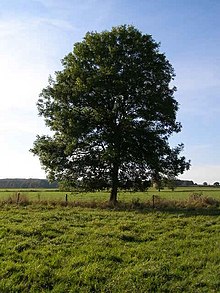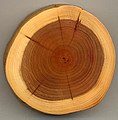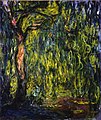The Trees Portal

In botany, a tree is a perennial plant with an elongated stem, or trunk, usually supporting branches and leaves. In some usages, the definition of a tree may be narrower, including only woody plants with secondary growth, plants that are usable as lumber or plants above a specified height. In wider definitions, the taller palms, tree ferns, bananas, and bamboos are also trees.
Trees are not a monophyletic taxonomic group but consist of a wide variety of plant species that have independently evolved a trunk and branches as a way to tower above other plants to compete for sunlight. The majority of tree species are angiosperms or hardwoods; of the rest, many are gymnosperms or softwoods. Trees tend to be long-lived, some reaching several thousand years old. Trees have been in existence for 370 million years. It is estimated that there are around three trillion mature trees in the world.
A tree typically has many secondary branches supported clear of the ground by the trunk, which typically contains woody tissue for strength, and vascular tissue to carry materials from one part of the tree to another. For most trees it is surrounded by a layer of bark which serves as a protective barrier. Below the ground, the roots branch and spread out widely; they serve to anchor the tree and extract moisture and nutrients from the soil. Above ground, the branches divide into smaller branches and shoots. The shoots typically bear leaves, which capture light energy and convert it into sugars by photosynthesis, providing the food for the tree's growth and development.
Trees usually reproduce using seeds. Flowers and fruit may be present, but some trees, such as conifers, instead have pollen cones and seed cones. Palms, bananas, and bamboos also produce seeds, but tree ferns produce spores instead.
Trees play a significant role in reducing erosion and moderating the climate. They remove carbon dioxide from the atmosphere and store large quantities of carbon in their tissues. Trees and forests provide a habitat for many species of animals and plants. Tropical rainforests are among the most biodiverse habitats in the world. Trees provide shade and shelter, timber for construction, fuel for cooking and heating, and fruit for food as well as having many other uses. In much of the world, forests are shrinking as trees are cleared to increase the amount of land available for agriculture. Because of their longevity and usefulness, trees have always been revered, with sacred groves in various cultures, and they play a role in many of the world's mythologies. (Full article...)
The Mingo Oak (also known as the Mingo White Oak) was a white oak (Quercus alba) in the U.S. state of West Virginia. First recognized for its age and size in 1931, the Mingo Oak was the oldest and largest living white oak tree in the world until its death in 1938.
The Mingo Oak stood in Mingo County, West Virginia, in a cove at the base of Trace Mountain near the headwaters of the Trace Fork of Pigeon Creek, a tributary stream of Tug Fork. The tree reached a height of over 200 feet (61 m), and its trunk was 145 feet (44 m) in height. Its crown measured 130 feet (40 m) in diameter and 60 feet (18 m) in height. The tree's trunk measured 9 feet 10 inches (3.00 m) in diameter and the circumference of its base measured 30 feet 9 inches (9.37 m). Assessments of its potential board lumber ranged from 15,000 feet (4,600 m) to 40,000 feet (12,000 m). Following the tree's felling in 1938, it was estimated to weigh approximately 5,400 long tons (5,500 t). (Full article...)Did you know? -
- ... that veneration of the Amla tree (pictured), in particular on Amalaka Ekadashi, is due to the belief that the god Vishnu resides in and near the tree?
- ... that the future of the tropical tree Milicia regia for timber production is threatened by a gall fly, Phytolyma lata?
- ... that the churchyard of All Saints Church, Ulcombe in England contains a yew tree claimed to be more than 2,000 years old?
- ... that seeds of the extinct tree Eucommia eocenica have been found with latex covered fossils?
- ... that the fruits of the Lecythis ampla tree resemble little wooden pots with lids?
- ... that fossilized seeds of the extinct tree Eucommia montana are found from British Columbia to Colorado?
- ... that the Australian tree Agathis atropurpurea is known as the black kauri or the blue kauri because of the colour of its bark?
Selected article -
The almond (Prunus amygdalus, syn. Prunus dulcis) is a species of small tree from the genus Prunus, cultivated worldwide for its seed, a culinary nut. Along with the peach, it is classified in the subgenus Amygdalus, distinguished from the other subgenera by corrugations on the shell (endocarp) surrounding the seed.
The fruit of the almond is a drupe, consisting of an outer hull and a hard shell with the seed, which is not a true nut. Shelling almonds refers to removing the shell to reveal the seed. Almonds are sold shelled or unshelled. Blanched almonds are shelled almonds that have been treated with hot water to soften the seedcoat, which is then removed to reveal the white embryo. Once almonds are cleaned and processed, they can be stored over time. Almonds are used in many cuisines, often featuring prominently in desserts, such as marzipan. (Full article...)General images
Selected lists
Subcategories
Related portals
Associated Wikimedia
The following Wikimedia Foundation sister projects provide more on this subject:
-
 Commons
Commons
Free media repository -
 Wikibooks
Wikibooks
Free textbooks and manuals -
 Wikidata
Wikidata
Free knowledge base -
 Wikinews
Wikinews
Free-content news -
 Wikiquote
Wikiquote
Collection of quotations -
 Wikisource
Wikisource
Free-content library -
 Wikispecies
Wikispecies
Directory of species -
 Wikiversity
Wikiversity
Free learning tools -
 Wiktionary
Wiktionary
Dictionary and thesaurus
-

-

-

-

-
Random portal

Purge server cache
































































